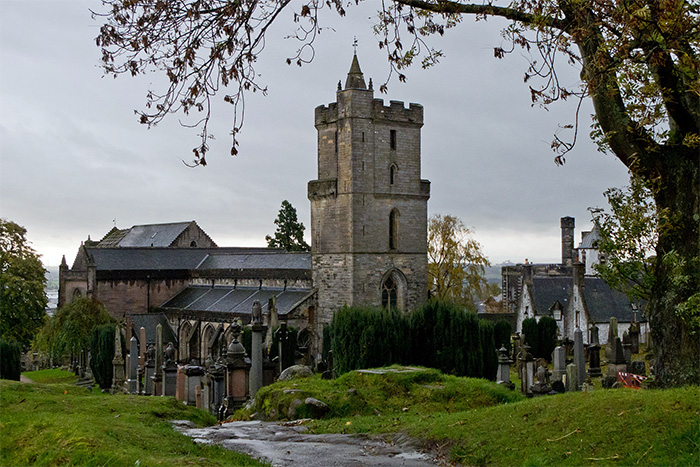
Historic Corstorphine, its Christian History and
Subsequent Connections with the Forrester Family
PART 6
by Annette Hixenbaugh, Oklahoma Regional Commissioner

Church of the Holy Rude. A view from the churchyard.
By Carlos Delgado (Own work) [CC BY-SA 3.0 (http://creativecommons.org/licenses/by-sa/3.0)], via Wikimedia Commons.
Adam was custodian, "de meneto regis", of Edinburgh Castle. He employed the mason, John of Scone on the building of David's Tower, started in 1367 and completed in 1377. Four PS Scots was paid in 1384 to a German gunmaker, Dedrik, who in four trial shots, demonstrated his invention to Adam---"unum instrumemtum dictum-gun". This was possibly a weapon considered for use on David's Tower, which with its rows of cannons, controlled the city until the Siege of 1573 by Regent Morton, who destroyed the fortification. Later the Half-Moon Battery was built over the ruined remains of David's Tower.
Robert III recognized Adam's faithful service by granting him in 1388, ten marks from the burgh mail (rents) of Edinburgh. Official state duties carried out by Adam included those of Auditor of Exchequer (13288-1404), Deputy Chamberlain (1388), and Keeper of the Great Seal (1390).
#803 Carta Hospitalis de Roxburgh states: "Robertus Dei gracis rex Scottorum Ade Forestar custody magnin sigilii nostril, cancellario nostro ooin remotis agente, salute..."
The Chamberlain's function was the collection, custody, and disbursement of the revenue along with supervision of the burghs.
"Robertus, etc. Sciatis nos dedisse, etc., dilecto et fieeli nostro Aee Forstar burgensi de Edynburghe, viginti marcas sterlingorum de firmis burgi nostri de Edyurghe in exchambium illarum viginti marcarum sibi per nos alias hereditare concessarum de custuma dicti burgi. Tenedas habendas et percipiendas eidem Ade et heredibus suis de nobis et heredibus nostris in feodo et hereditate, libere, etc. Testibus ut supra Apud Edynburgh, quarto die Julii anno regnni nostri terciodecimo."
For helping Sir Thomas Erskine of Dun out of his financial difficulties in 1385, Adam got the lands of Cakery in Forfarshire, which he kept until 1405 when Erskine was able to redeem them. The Forrester connection with Erskine of Dun was made even more secure when Sir Alexander Forrester of Garden married Jean Erskine, daughter of John Erskine of Dun. Their tombs are in the Forrester Chapel in the Church of the Holy Rude in Sterling, Scotland.
After the English raids on Edinburgh in 1385, in which the parish church of St. Giles suffered damage, Adam, acting on behalf of the town, drew up an indenture on 29th November 1387 with three masons - John Primrose, John of Sconne, and John Squire - to build five chapels on the south side of an existing nave. The five survived until 1829 when the architect, Burn, started his "restoration work". Over one chapel was a small chamber, where in 1829 were found ancient city records. For long, it was thought that the present inner and outer south nave aisles were Adam's five chapels, but present architectural opinion, does not accept this theory on the grounds that they do not correspond to the architectural details in the indenture document. Adam gifted money to maintain a priest at the altar of St. Ninian in St. Giles.
